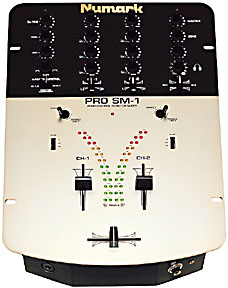

| Contents: | The Mixer |
|
An audio mixer is a device that takes mutiple audio inputs and allows the user to blend them together for a single output. Typically a DJ would have a combination of turntables and CD players feeding into a mixer while the output is sent to an amplifier.  Most standard DJ mixers come with (at least) two channels, a set of three equalizers for each channel and a crossfader to fade smoothly between each channel. Each audio source (eg. a turntable) is connected to one channel on the mixer. Each channel has a volume slider which controls the amount of volume that the source will output from the mixing board. There is usually also a LED meter to indicate how many decibels a channel is emitting. Controlling the volume of a source is a one dimensional continous task. Knobs or sliders could be used. Sliders are generally prefers as they can offer more precision in picking the correct volume. They are also usually easier to control as the hand must move up and down instead of twisting around. The equalizers for a channel usually consist of three knobs that allow the user to adjust the low, middle and high frequencies. Bass tones are generally in the lower frequencies of a track. Vocals and instruments like trumpets and pianos reside in the middle frequencey ranges and higher tones such as hi-hats and cymbals are found in the high frequncey ranges. Each mixer is differnt and so there is no standard as to the exact frequency ranges each of these knobs will control. DJs can choose which instruments of a track are accented by adjusting the equalizer knobs. Some mixers allow the DJ to cut those sounds out completely while others provide a range from -32dB to +32dB in sound. Generally if a freqency range is cut back to anything less that -12dB of sound, it is difficult to hear and the DJ can "pseudo-eliminate" it by playing sounds from another source within the same frequency. Adjusting the frequency ranges is a one dimensional continuous task that is usally performed with knobs. Sliders may provide more precision with this but take up much more room than knobs. Also, most mixers only allow access to three preset frequency ranges and do not let the DJ decide where the boundary for the ranges will exist. This also limits the amount of control within a certain frequency range. One low frequency knob can control an entire frequency range which limits precision. The crossfader is one of the most important aspects of a mixer for DJs who want to perform tricks while mixing. The crossfader allows the DJ to move the output of the mixing board from one channel to another in a manner than incrementally decreases the volume of one source while proportionally increasing the volume of the second source. The crossfader is a continous control that slides back and forth between two channels. When it is on one side, the output consists of just one source. When it is on the other side, the output consists of the other source. When in the middle, the output is an equal combination of both sources. By snapping the crossfader back and forth with acuracy and speed, a DJ can perform certain tricks with the music such as studders, snapping sounds and quick shifts in music. Most crossfaders wear out in time and start to "bleed". Bleeding is when the crossfader is completly on one side but some of the other source can still be heard "bleeding" through the mixer. This damage is caused by the repetitve snapping of the crossfader on the sides of the control. |